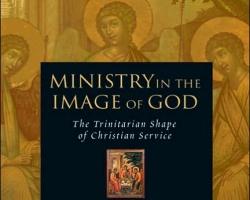Ministry in the Image of God: The Trinitarian Shape of Christian Service
Stephen Seamands
Intervarsity Press, 2005, 189 pp., $15
In Ministry in the Image of God, Seamands explores the impact of the Trinity on the function of ministry. He begins looking at the need to recognize the working of the Trinity in the task and motivation of ministry. He points out the fact that the Trinity helps us view the relational aspect of ministry through the lens of the Father, Son and Holy Spirit.
We must be open and honest with God in order to create intimacy with Him. Intimacy is something that I think is misunderstood. In our society, intimacy is equated with sex. I believe true intimacy occurs when we really get to know people and allow ourselves to be known. We each long to be understood and accepted. If we can connect with others on more than just a superficial level, we can attain true intimacy. I think we can really experience God when we are honest with Him. He knows us and longs for us to know Him.
Seamands also points out the surrendering of our lives to serve Christ is a human expression of the attitude of how each member of the Trinity relates to the other. The Trinity sounds simple, but the Trinity is our feeble effort to define the attributes of God. This mystery helps provide a framework for service and ministry. The uniqueness of each member of the Trinity allows ministry to be shaped and colored in special ways to accomplish God’s mission. The fact that we are filled with the Holy Spirit allows us to allow every member of the Trinity to work in and through us.
Finally, Seamands closes with the thought that the work of the Trinity helps control the heartbeat and origin of the ministry that we fulfill. The Bible points to the fact that the Trinity refers to the triune personalities of God. If you look to the early church fathers, the Trinity was an issue they spent a lot of time trying to wrap their minds around. It is still true today. We must develop a clear theology of the Trinity and be able to articulate it well if we are going to communicate this major tenant of our faith with those who are seeking to join in a conversation with the God who created them. We hold to the substance of the Trinity but have no clue how to articulate it. God did not give us much information on how He can be three and one, but I think the more we get to know Him and really follow Him, it will become clearer. For example, I knew my role as a son as I was growing up. I dreamed one day of being a husband and a father. I knew I would reach that goal one day, and believed I could be all three (son, father and husband); but until I became intimately involved in each of those areas, I really did not understand those roles. The same is true with God. The more we understand the role of the Father, Son and Holy Spirit, the better equipped we will be to do ministry.
The Trinity has been evident from the beginning of time. Creation is a perfect example of the Trinity working together to accomplish God’s overall purpose. In
Jesus also played a vital role in creation. In
The Holy Spirit is the unifying factor within the Trinity. What I mean by that is He can be explained by the analogy of a person. God is the head. All things originate from the head and thus communicates to the body. The body is Christ. He is the active part of the Trinity that executes the head’s will. The Holy Spirit is like the blood that flows through the body unifying the Trinity. The Holy Spirit’s role is to help conform us to the image of Christ. This process is know as sanctification, but I like to refer to it as transformation. It is a process by which we become more like Jesus.
Today, we live in a world that is so complex. The hustle and bustle of our society tends to drown out the inner voice inside of us that’s trying so hard to be heard. We all long to be free — not just free of our worries and cares but to be totally free the way God intended us to be. So how do we get there? How do we navigate our way through this maze called life? The key is transformation. A caterpillar cannot truly be free and become what God intended it to be until it goes through a transformation process and becomes a butterfly. If that is true in nature, then why not for us? The transformation process is not an easy one. Very few people could explain what it means to be transformed. In order to begin this journey, we must do an inventory of who we are. Who are we created to be? We must be liberated from this hectic, burdensome life and live a life of freedom that Christ has in store for all of us. In order to be truly free, we must allow Christ to be in total control of our lives by yielding to the Holy Spirit’s work in and let Him have total control.
The Holy Spirit allows us to represent Christ on earth. We will have the same spirit and mind of Christ if we tap into the power and guidance the Holy Spirit offers in order for us to form our ministry in the God’s image.




